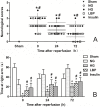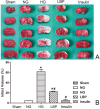Lycium Barbarum Polysaccharides Decrease Hyperglycemia-Aggravated Ischemic Brain Injury through Maintaining Mitochondrial Fission and Fusion Balance - PubMed (original) (raw)
. 2017 Jul 7;13(7):901-910.
doi: 10.7150/ijbs.18404. eCollection 2017.
Affiliations
- PMID: 28808422
- PMCID: PMC5555107
- DOI: 10.7150/ijbs.18404
Lycium Barbarum Polysaccharides Decrease Hyperglycemia-Aggravated Ischemic Brain Injury through Maintaining Mitochondrial Fission and Fusion Balance
Wen-Jing Liu et al. Int J Biol Sci. 2017.
Abstract
Although it has been reported that polysaccharides found in Lycium barbarum possess neuroprotective effects, little is known of their ability to ameliorate hyperglycemia-aggravated ischemia/reperfusion brain injury. In this study, normoglycemic (NG) and hyperglycemic (HG) rats were compared after 30 minutes of middle cerebral artery occlusion (MCAO), followed by 24 or 27 hours of reperfusion, with HG rats pretreated with lyceum barbarum polysaccharides (LBP) or insulin. In each group, the neurological deficit, infarct volume, pathohistology, and expression of proteins, Opa1 and Drp1, were assessed to determine the efficacy of LBP in alleviating hyperglycemia-aggravated ischemia/reperfusion brain injury. Our results show that, compared to the NG group, the HG group had increases in neurological deficits, infarct volume, and evidence of neuronal pyknosis at 24- and/or 72-h of reperfusion (P<0.05) and that pre-treatment with LBP decreased these effects (P<0.05). In addition, immunohistochemistry revealed an increase of Drp1 and a decrease of Opa1 positive neurons in the HG group after 24 and 72 hours of reperfusion when compared to the NG group. LBP treatment prevented the HG-induced alterations in Drp-1 and Opa1 expression. Western blots further confirmed these findings showing that HG caused an increase in phospho-Drp1 and a decrease in Opa1 which were subsequently reversed by LBP addition. These results suggest that hyperglycemia-aggravated ischemic brain damage is associated with an alteration of mitochondrial dynamics and that pre-treatment with LBP ameliorates the hyperglycemia-enhanced ischemic brain damage through maintaining mitochondrial dynamic balance.
Keywords: Lycium barbarum polysaccharides; cerebral ischemia and reperfusion; dynamin-related protein 1; hyperglycemia; mitochondrial fission/fusion; neuroprotection; optic atrophy 1..
Conflict of interest statement
Competing Interests: The authors have declared that no competing interest exists.
Figures
Figure 1
Body weight and blood glucose changes in NG, HG, LBP, and Insulin groups after STZ administration and after LBP or insulin therapy. A, Summary of body weights; B, Summary of blood glucose levels. *P<0.05, vs. NG group; #P<0.05, vs. HG group, respectively.
Figure 2
Neurological deficits score and T-maze test in sham, NG, HG, LBP and Insulin groups after MCAO and 24- or 72-h reperfusion. A, Summary of the neurological deficits score; B, Summary of the time in T-maze test. *P<0.05,vs. NG group; #P<0.05, vs. HG group, respectively.
Figure 3
Comparison of infarct volumes after 24 hours reperfusion. A, Representative brain sections stained with TTC. Pale areas show infarct volume of the hemisphere in HG and LBP groups; B, Quantitative summary of infarct volumes. *P<0.05, vs. sham group; #P<0.05, vs. HG group, respectively.
Figure 4
Observed histopathology and changes in number of pyknotic cell in NG, HG, LBP and Insulin groups. A, Representative pictograghs of the cortex after 24 and 72 hours reperfusion. Normal histology and neurons are indicated by arrow heads in the sham groups; solid arrows point to pyknotic and swollen neurons after 24 hours reperfusion; glial cells are indicated by empty arrows and compared at 72-h reperfusion. Bar = 100μm. B, Quantitative summary of pyknotic cells; *P<0.05, vs. NG group; #P<0.05, vs. HG group, respectively.
Figure 5
Expression of Opa1 in NG, HG, LBP, and Insulin groups after 24 and 72 hours of reperfusion. A, Representative pictograghs showing immunohistochemistry staining of Opa1. Opa1 positively stained cells appear brown against a blue counterstain (hematoxylin). Yellow arrow heads indicate positively stained cells. Bar = 50 μm. B, Quantitative summary showing the number of Opa1-positive cells; *P<0.05, vs. NG group; #P<0.05 vs. HG group, respectively.
Figure 6
Expression of Drp1 in NG, HG, LBP and Insulin groups after 24 and 72 hours of reperfusion. A, Representative pictograghs showing immunohistochemistry staining of Opa1. Opa1 positively stained cells appear brown against a blue counterstain (hematoxylin). Yellow arrow heads indicate positively stained cells. Bar = 50 μm. B, Quantitative summary showing the number of Drp1-positive cells; *P<0.05, vs. NG group; #P<0.05, vs. HG group, respectively.
Figure 7
Western blotting analysis of Drp1 and Opa1 after 24 and 72 hours of reperfusion. A, Representative Western blot of Opa1, Drp1, and phospho-Drp1; B, Summary of relative values of Opa1; C, Summary of the ratio of phospho-Drp1/Drp1; *P<0.05, vs. NG group; #P<0.05, vs. HG group, respectively.
Similar articles
- Lycium Barbarum polysaccharides ameliorates hyperglycemia-exacerbated cerebral ischemia/reperfusion injury via protecting blood-brain barrier.
Zhao Q, Jing YM, He MT, Jing L, Xi YF, Zhang JZ. Zhao Q, et al. Transpl Immunol. 2023 Feb;76:101757. doi: 10.1016/j.trim.2022.101757. Epub 2022 Nov 24. Transpl Immunol. 2023. PMID: 36436794 - Potential cerebrovascular protective functions of lycium barbarum polysaccharide in alleviating hyperglycemia-aggravated cerebral ischemia/reperfusion injury in hyperglycemic rats.
Jiang HF, Guo YQ, Rehman FU, Jing L, Zhang JZ. Jiang HF, et al. Eur Rev Med Pharmacol Sci. 2022 Oct;26(20):7379-7394. doi: 10.26355/eurrev_202210_30007. Eur Rev Med Pharmacol Sci. 2022. PMID: 36314308 - Coenzyme Q10 ameliorates cerebral ischemia reperfusion injury in hyperglycemic rats.
Lu CJ, Guo YZ, Zhang Y, Yang L, Chang Y, Zhang JW, Jing L, Zhang JZ. Lu CJ, et al. Pathol Res Pract. 2017 Sep;213(9):1191-1199. doi: 10.1016/j.prp.2017.06.005. Epub 2017 Jun 15. Pathol Res Pract. 2017. PMID: 28698101 - An evidence-based update on the pharmacological activities and possible molecular targets of Lycium barbarum polysaccharides.
Cheng J, Zhou ZW, Sheng HP, He LJ, Fan XW, He ZX, Sun T, Zhang X, Zhao RJ, Gu L, Cao C, Zhou SF. Cheng J, et al. Drug Des Devel Ther. 2014 Dec 17;9:33-78. doi: 10.2147/DDDT.S72892. eCollection 2015. Drug Des Devel Ther. 2014. PMID: 25552899 Free PMC article. Review. - [Resources industrialization channels and strategies of active polysaccharide from Lycii Fructus based on analysis of domestic and foreign intellectual properties].
Zhang F, Guo S, Qian DW, Zhang X, Yang XC, Li YJ, Duan JA. Zhang F, et al. Zhongguo Zhong Yao Za Zhi. 2016 Dec;41(23):4285-4291. doi: 10.4268/cjcmm20162301. Zhongguo Zhong Yao Za Zhi. 2016. PMID: 28933102 Review. Chinese.
Cited by
- Lycium barbarum glycopeptide promotes neuroprotection in ET-1 mediated retinal ganglion cell degeneration.
Lakshmanan Y, Wong FSY, So KF, Chan HH. Lakshmanan Y, et al. J Transl Med. 2024 Aug 5;22(1):727. doi: 10.1186/s12967-024-05526-8. J Transl Med. 2024. PMID: 39103918 Free PMC article. - Potential role of Lycium barbarum polysaccharides in glaucoma management: evidence from preclinical in vivo studies.
Lakshmanan Y, Wong FSY, So KF, Chan HH. Lakshmanan Y, et al. Neural Regen Res. 2023 Dec;18(12):2623-2632. doi: 10.4103/1673-5374.355977. Neural Regen Res. 2023. PMID: 37449600 Free PMC article. - MSCs Ameliorate Hepatic IR Injury by Modulating Phenotypic Transformation of Kupffer Cells Through Drp-1 Dependent Mitochondrial Dynamics.
Shang LC, Wang M, Liu Y, Zhu X, Wang S. Shang LC, et al. Stem Cell Rev Rep. 2023 Aug;19(6):1965-1980. doi: 10.1007/s12015-023-10566-6. Epub 2023 May 27. Stem Cell Rev Rep. 2023. PMID: 37243829 - Traditional Chinese medicine in treating ischemic stroke by modulating mitochondria: A comprehensive overview of experimental studies.
Liu L, Chen D, Zhou Z, Yuan J, Chen Y, Sun M, Zhou M, Liu Y, Sun S, Chen J, Zhao L. Liu L, et al. Front Pharmacol. 2023 Mar 22;14:1138128. doi: 10.3389/fphar.2023.1138128. eCollection 2023. Front Pharmacol. 2023. PMID: 37033646 Free PMC article. Review. - Fungal pathogens causing postharvest fruit rot of wolfberry and inhibitory effect of 2,3-butanedione.
Ling L, Luo H, Zhao Y, Yang C, Cheng W, Pang M. Ling L, et al. Front Microbiol. 2023 Jan 10;13:1068144. doi: 10.3389/fmicb.2022.1068144. eCollection 2022. Front Microbiol. 2023. PMID: 36704548 Free PMC article.
References
- Jiao R, Liu Y, Gao H. et al. The anti-oxidant and antitumor properties of plant polysaccharides. Am J Chin Med. 2016;44(3):463–88. - PubMed
- Yang X, Bai H, Cai W. et al. Lycium barbarum polysaccharides reduce intestinal ischemia/reperfusion injuries in rats. Chem Biol Interact. 2013;204(3):166–72. - PubMed
- Zhang R, Kang KA, Piao MJ. et al. Cytoprotective effect of the fruits of Lycium chinense Miller against oxidative stress-induced hepatotoxicity. J Ethnopharmacol. 2010;130(2):299–306. - PubMed
- Yu MS, Lai CS, Ho YS. et al. Characterization of the effects of anti-aging medicine Fructus lycii on beta-amyloid peptide neurotoxicity. Int J Mol Med. 2007;20(2):261–8. - PubMed
Publication types
MeSH terms
Substances
LinkOut - more resources
Full Text Sources
Other Literature Sources
Medical
Research Materials
Miscellaneous






